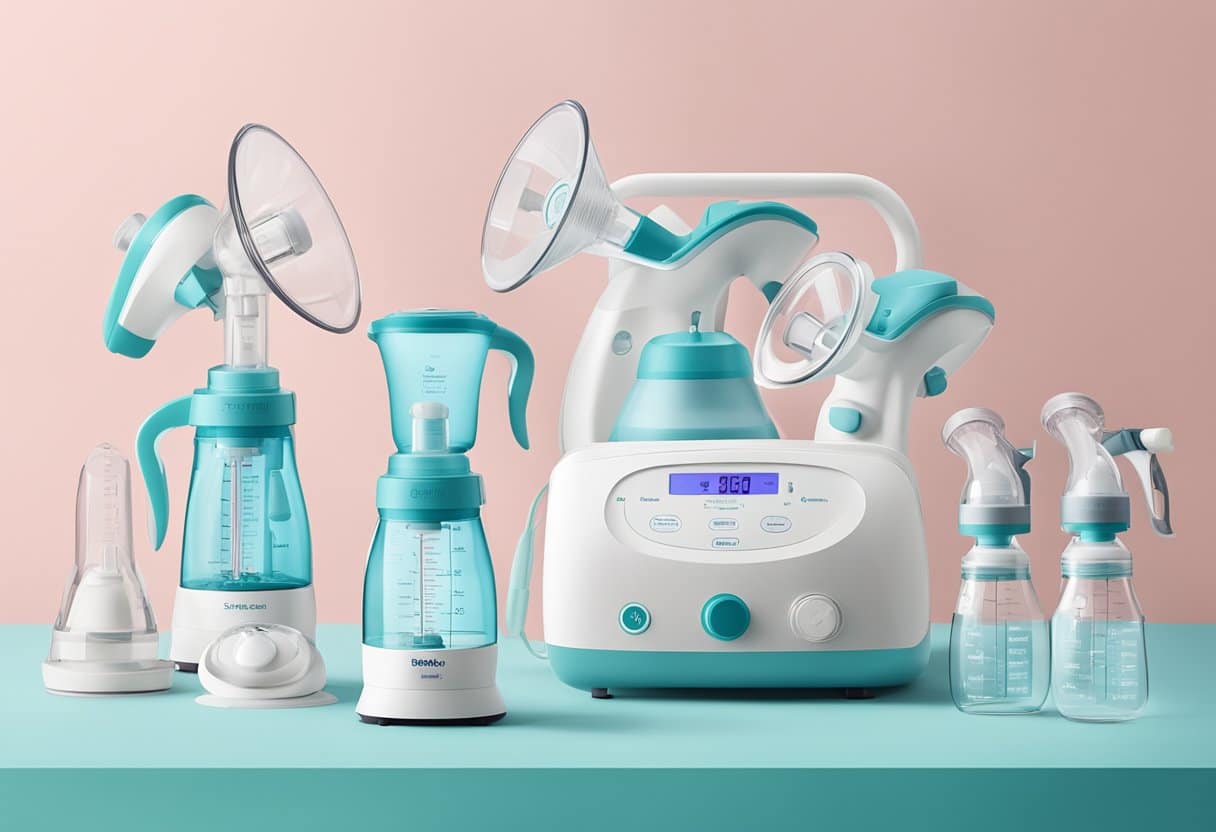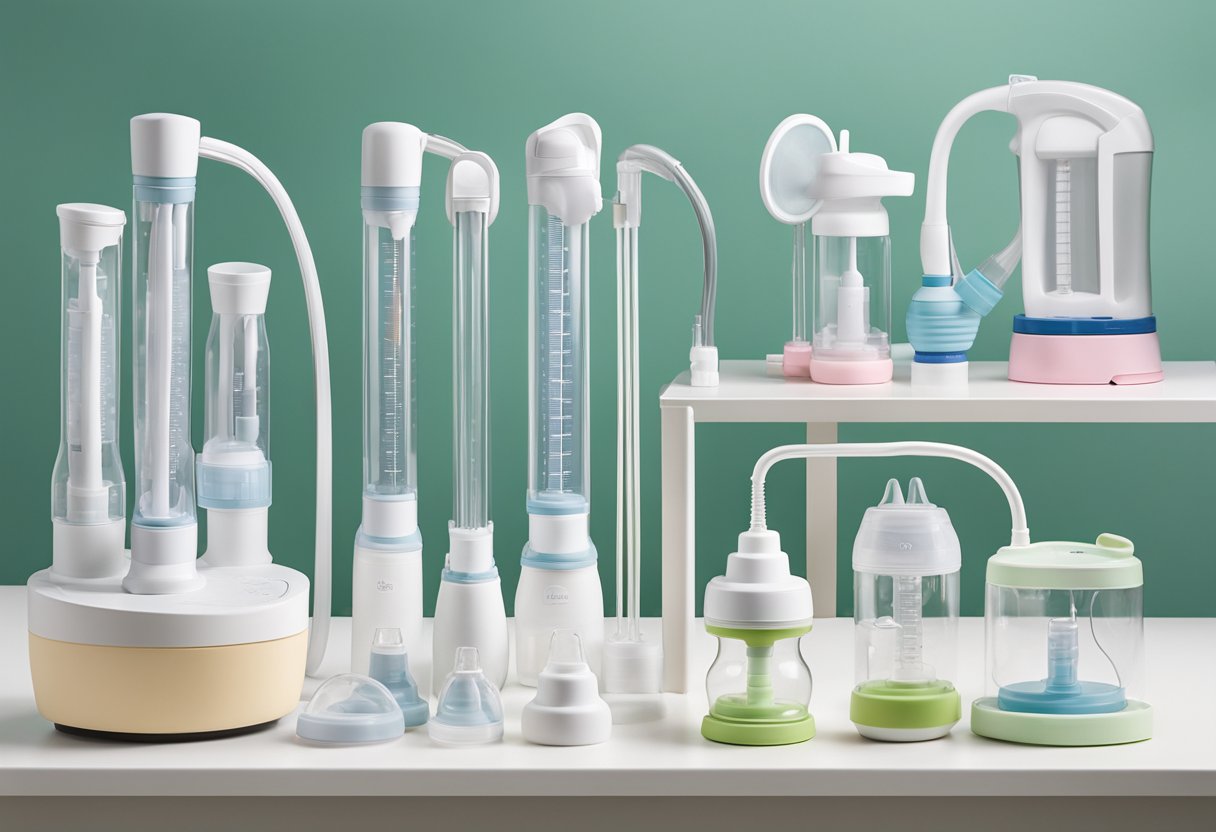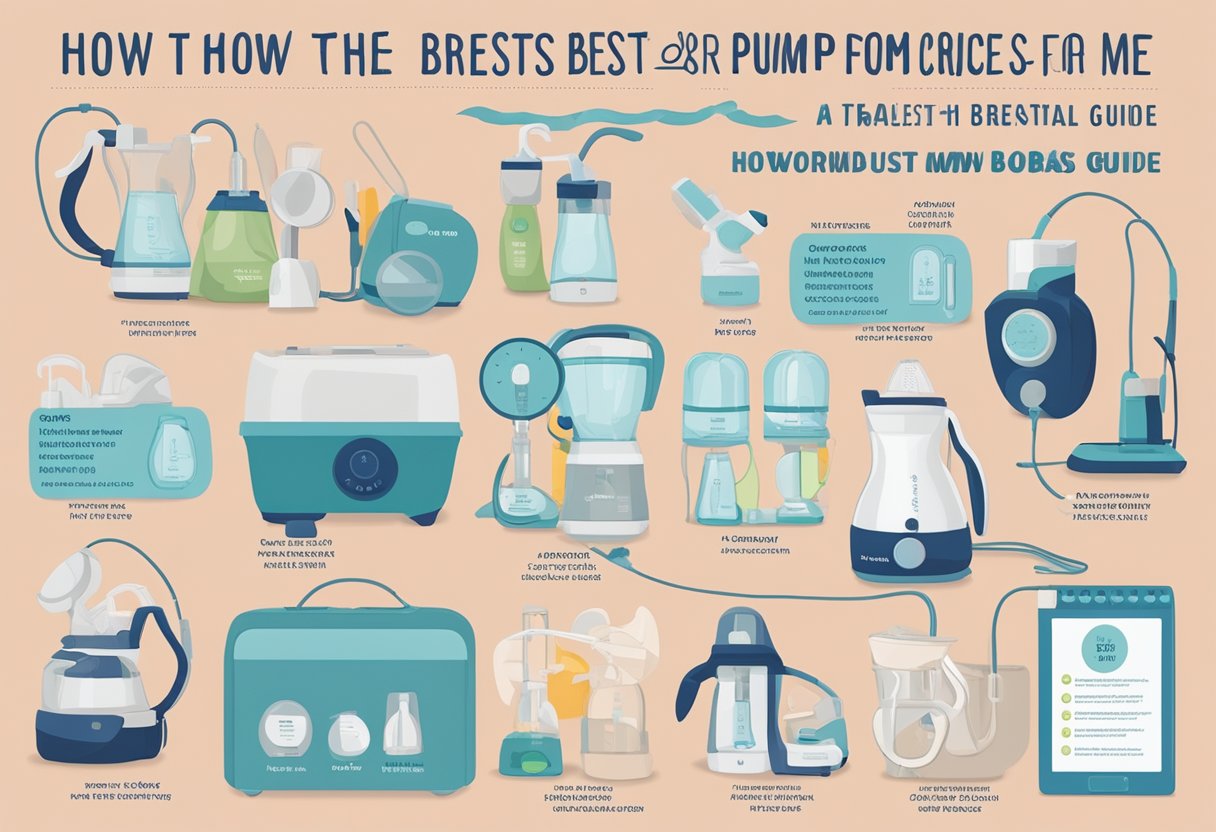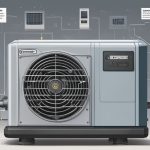Choosing the best breast pump is a decision that can significantly impact a new mother’s breastfeeding journey. With the market offering an array of options, from electric to manual pumps, wearable technology, and hospital-grade machines, the task of finding the perfect pump can be overwhelming. It’s crucial to consider your lifestyle, pumping frequency, and specific needs when selecting a breast pump. Factors such as comfort, efficiency, portability, and ease of cleaning play a significant role in determining the right choice.
A breast pump serves as an essential tool for many parents, enabling them to provide breast milk to their babies even when they are apart, or to alleviate issues like engorgement and low supply. Understanding the different types of pumps available, how to use them effectively, and the best ways to store breast milk ensures that parents can preserve this vital source of nutrition for their infants. With the right pump, breastfeeding goals become more attainable, and the process becomes less stressful for both mother and baby.
Key Takeaways
- Selecting a breast pump that fits a mother’s individual needs is vital for a successful breastfeeding experience.
- Knowledge of breast pump types and their uses enhances milk expression and storage practices.
- Proper cleaning, maintenance, and understanding insurance coverage contribute to an efficient pumping routine.
Understanding Breast Pumps
When selecting a breast pump, first consider the types available:
- Manual Breast Pumps: Operated by hand, they require the user to pump a handle to create suction. These are quiet and portable but may be tiring over time.
- Electric Breast Pumps: Powered by batteries or electricity, they automate suction and often offer variable settings. They can be single or double, with double pumps allowing for pumping both breasts simultaneously.
- Wearable Breast Pumps: Designed for discretion, these fit into a bra and enable pumping without wires or external bottles.
- Hospital-Grade Pumps: Known for powerful suction and durability, these are often used by multiple users in clinical settings.
Next, assess the suction and pumping mechanism:
- Quality suction is crucial for efficiency and comfort. Look for a pump that mimics a baby’s natural nursing rhythm.
- Many electric and hospital-grade pumps provide adjustable suction levels to suit individual comfort and milk flow.
Other factors to consider involve ease of assembly, cleaning, and portability. A good breast pump should balance these with performance to fit into the user’s lifestyle—whether it’s for occasional, daily home use, or when returning to work.
Lastly, remember that individual needs vary, and one pump type does not fit all. It’s important to evaluate personal requirements, such as how often they will pump and the setting in which they will do so, before making a purchase.
Types of Breast Pumps
When selecting a breast pump, it is important to understand the different types available. They can be broadly categorized into manual and electric pumps, each with features catering to varied lifestyles and needs.
Manual Pumps:
These are operated by hand and are often praised for their simplicity and portability. A user can control the suction rhythm, making it a personalized experience. They are typically more affordable and quieter than electric pumps, making them suitable for occasional use or as a backup.
Electric Pumps:
Electric pumps provide powered suction, requiring less effort than manual pumps. They can be further distinguished between:
- Single Electric Pumps: Designed for one breast at a time, suitable for mothers who pump infrequently.
- Double Electric Pumps: Enable pumping from both breasts simultaneously, which is more efficient and can halve the pumping time.
Electric pumps usually offer multiple suction levels and patterns that can mimic a baby’s natural nursing rhythm. For moms who need to pump regularly or return to work, a double electric breast pump may be an excellent investment.
Battery-Powered Pumps:
Offering the convenience of an electric pump without the need for a power outlet, battery-powered pumps are a good option for on-the-go pumping. They tend to be light and portable but may require frequent battery changes or recharging.
Wearable Pumps:
Wearable breast pumps are a newer category that boasts discretion and mobility, allowing a mother to pump hands-free while doing other activities. These pumps fit directly into the bra, and though they can be more expensive, they provide unparalleled convenience for busy parents.
Portable Pumps:
For those who need to pump away from home, portable pumps combine the power of an electric pump with the mobility of a battery-powered unit. Pumps like the lightweight Baby Buddha offer a balance of effectiveness and portability.
Choosing the Right Breast Pump
When one is navigating the breast pump market, comfort and lifestyle should drive their decision-making process. They must consider how frequently they will be using the pump. For mothers who will be away from their baby often or returning to work full-time, an electric breast pump is a staple. It’s efficient and saves time. If the pumping will be less frequent or for occasional relief, a manual pump might suffice, being both quieter and more portable.
Type of Breast Pumps:
- Electric: For regular use, designed for efficiency.
- Manual: Best for infrequent use, quieter, and more portable.
- Wearable: Allows one to pump discreetly when on the move.
To ensure a comfortable experience, one must look for a pump that comes with multiple breast shield sizes. A correct fit is crucial for both comfort and efficiency. Some breast pumps are described as “hospital-grade,” which typically means they have a more powerful motor and can be used by multiple users safely.
Ease of Cleaning is another vital factor. Breast pumps with fewer parts or dishwasher-safe components can save valuable time and effort.
Lastly, one should choose a pump that aligns with their lifestyle needs. If they are often on the go, a lightweight, and possibly wearable, pump would be a practical choice. Battery-operated or rechargeable pumps offer flexibility for mothers without constant access to a power source.
| Lifestyle Considerations | Recommendations |
|---|---|
| Frequent Pumping Needs | Look at electric breast pumps |
| Infrequent, Occasional Use | Consider a manual breast pump |
| On-the-Go Pumping | Investigate wearable pumps |
| Power Source Availability | Seek out battery-operated or rechargeable options |
Adhering to these guidelines will ensure that the chosen breast pump is both efficient for milk expression and supportive of their comfort and lifestyle.
How to Use a Breast Pump
When using a breast pump, one should first assemble the device according to the manufacturer’s instructions. This typically involves connecting the breast shields, bottles, valves, and tubing. A clean, flat surface and privacy are advisable for comfort during the process.
Before beginning, hands should be washed and the breasts gently massaged to stimulate expression. The breast shield should be centered over the nipple, ensuring a proper seal to facilitate effective suction. It’s essential to start with a low suction setting before gradually increasing to a comfortable level.
- Manual pumps: These are operated by hand and often require a rhythmic squeezing action.
- Electric pumps: These provide automatic suction and may offer multiple settings for suction strength and speed.
Cleaning the pump after each use is crucial to maintain hygiene. Components should be detached and washed in hot, soapy water then air-dried on a clean towel. Many models also allow for certain parts to be sterilized or cleaned in a dishwasher.
Users should store milk in clean bottles or storage bags, labeling them with the date of expression. Refrigerated or frozen breast milk should be thawed under warm water or in the refrigerator to maintain nutrients.
Remember, comfort is paramount, and it may take time to get accustomed to the sensations of pumping. If discomfort or issues with pumping occur, consulting a lactation specialist is advisable. They can also provide personalized tips for optimizing the use of a breast pump.
Breast Pump Accessories
When selecting breast pump accessories, understanding their function and compatibility with your pump can ensure an efficient and comfortable pumping experience. Flanges, also known as breast shields, are crucial for comfort and proper milk flow. They come in various sizes, and one should choose the size that fits their nipple size without causing discomfort.
Coolers are essential for mothers who need to store their milk after pumping, especially when on the go. They keep breast milk at a safe temperature for extended periods. A carrying case is equally beneficial, providing a convenient and discreet way to transport the breast pump and its components.
Here is a basic list of accessories that can enhance the pumping experience:
- Flanges/Breast Shields: Ensure a correct fit for maximum efficiency and comfort.
- Coolers: Keep milk at the appropriate temperature for several hours.
- Carrying Case: Facilitate pump and accessory transportation.
A quality nursing bra is also invaluable, accommodating the flanges and providing hands-free pumping capability. This can be a game-changer for multitasking mothers.
Additionally, one may also consider purchasing spare parts and cleaning supplies to maintain their pump. It’s essential for individuals to review their breast pump model and choose accessories that are compatible and meet their specific needs.
Cleaning and Maintenance
When choosing a breast pump, one should consider the ease of cleaning and maintenance, as it is crucial for the safety and longevity of the device. It’s recommended to clean all breast pump parts that come into contact with breast milk after each use. This includes flanges, bottles, valves, and membranes.
Cleaning Steps:
- Begin by washing hands thoroughly with soap and water for at least 20 seconds.
- Disassemble the breast pump parts.
- Rinse all separated parts that have come into contact with breast milk in cool water to remove residual milk.
- Clean parts using warm soapy water; use a brush dedicated to cleaning the pump parts only.
- Rinse again in hot water for 10-15 seconds.
- Allow parts to air-dry on a clean towel or drying rack.
Note: Some parts may be dishwasher safe; consult the manufacturer’s instructions for specific details.
Sterilization should be done regularly, especially for those sharing a pump or with infants in intensive care. Options for sterilization include using a microwave steam bag, boiling parts in water, or using a countertop sterilizer.
Advice for Maintenance:
- Inspect the pump kit and tubing regularly for mold or soiling. Replace moldy or damaged parts immediately.
- Store all components in a clean, dry place when not in use.
- Keep the motor unit and battery pack (if applicable) away from water. Wipe these down with a clean cloth as needed.
Consistent cleaning and proper maintenance ensure optimal function of the breast pump and safeguard the baby’s health. These practices not only prolong the life of the pump but also contribute to a more pleasant and efficient pumping experience.
Pumping and Milk Storage
Choosing the right breast pump and understanding proper breast milk storage are crucial to ensuring a convenient pumping experience and maintaining the quality of breast milk for your baby. The following points offer guidance on effective milk expression and appropriate storing techniques.
Effective Milk Expression
For effective milk expression, one needs a breast pump that matches their individual needs, with an emphasis on comfort and efficiency. Electric breast pumps typically provide more power and options for suction level and speed, which can make the pumping process faster and more comfortable. The goal during pumping is to mimic a baby’s natural nursing rhythm, a combination of stimulation and expression. This dual-phase process helps to efficiently extract milk.
Some breast pumps available in 2024 are appreciated by parents for their ease of use and effectiveness, with various models recommended by Babygear experts and real parents. For instance, hands-free pumps allow for multitasking, and the Spectra S1 Plus Electric is often highlighted due to its efficient suction level and portability.
Storing Breast Milk
Once breast milk has been expressed, proper storage is key. Always use clean containers, such as breast milk storage bags or food-grade bottles with tight-fitting lids. For short-term use, breast milk can be stored in a refrigerator for up to four days at a temperature of 4°C (39°F) or colder. If you need to store breast milk for longer, a freezer can keep it safe for use for up to 6 months to a year, although using it within 6 months is recommended to preserve the best quality.
Here is a simple table summarizing breast milk storage guidelines for your convenience:
| Location | Temperature | Duration |
|---|---|---|
| Refrigerator | 4°C (39°F) or colder | Up to 4 days |
| Freezer | -18°C (0°F) or colder | Up to 6 months (best quality) to 12 months |
Remember to label each container with the date of pumping to follow a first-in, first-out schedule which ensures older milk is used before fresher supplies. When thawing frozen milk, do it in the refrigerator or by setting the container in lukewarm water, and avoid refreezing thawed milk to preserve its quality and nutrients.
Troubleshooting Common Issues
When facing issues with a breast pump, it’s crucial to identify the problem accurately to find an effective solution. Here’s a guide to help troubleshoot some of the common problems.
- Noise: A noticeable increase in noise can indicate a motor problem. Check for loose parts or debris inside the pump. If the noise persists, consult the manufacturer’s guidelines, as the motor may need maintenance or replacement.
- Suction Problems: Weak suction may result from several factors:
- Ensure all connections are secure and the valves are properly attached.
- Examine membranes for wear and tear—replace them if needed.
- Check the tubing for blockages or air leaks.
Use the following table to address suction issues:
Issue Solution Leaks in tubing Confirm all connections; replace tubing if cracked. Worn-out valves or membranes Replace with new components. Motor performance Recharge battery or contact support for motor assessment. - Motor Troubles: If the breast pump motor does not start:
- Make sure the pump is adequately charged or plugged in.
- Reset the pump if it has a reset function.
- If the motor still does not respond, refer to the warranty or customer support for assistance.
- Resolving Common Problems:
- Regularly clean all parts according to manufacturer’s instructions to prevent issues.
- Keep spare parts like membranes and valves accessible to quickly resolve suction problems.
- Contact customer service for persistent or complex issues, especially if related to the motor or electronic components.
Breast Pump Insurance Coverage
Many insurance plans cover the cost of breast pumps under the Affordable Care Act (ACA). A buyer must consult with their insurance provider to understand their coverage options. Coverage can vary based on the insurance plan and may require purchasing from approved suppliers.
- Consult Your Insurance: Contacting your insurance provider is the first step. They will provide information on the types of pumps available – whether manual or electric – and the coverage extent.
- Prescription Requirements: A prescription from a healthcare provider might be necessary. Some insurance plans only cover the cost if the breast pump is medically indicated.
- Timing: The timing of when one can receive a breast pump varies; some plans allow for a breast pump before the baby’s birth, others after delivery.
Network Providers:
- If the insurance plan has a network of preferred providers, buying a breast pump from these suppliers can be crucial for coverage.
Rental vs. Purchase:
- Determine whether your plan covers the rental of a hospital-grade breast pump or if it only applies to the purchase of a personal-use pump.
Reimbursement:
- Some insurers may offer reimbursement, requiring the buyer to pay upfront. It’s important to keep all receipts and necessary documentation for claims.
Following these steps can help ensure that one gets a breast pump at an affordable price or, in some cases, free of charge, in compliance with insurance coverage guidelines.
| Insurance Steps | Notes |
|---|---|
| Confirm Coverage | Coverage details, including pump types and costs. |
| Provider Network | List of in-network suppliers. |
| Required Documentation | Prescriptions or medical necessity forms. |
| Purchase or Rental | Policy on buying vs. renting. |
| Reimbursement Process | Steps for submitting receipts for reimbursement. |
Expert Advice and Support
When choosing the perfect breast pump, seeking the advice of professionals is invaluable. They provide tailored recommendations based on individual needs and experiences.
- Lactation Consultants: Certified lactation consultants are a wealth of knowledge, offering guidance on pump selection, fitting, and technique. They often have hands-on experience with different pump models and can advise on ones that match comfort and efficiency needs.
- Lactation Experts: Lactation experts may also provide insights into the latest technology and trends in breast pumps. Their expertise ensures one is well-informed about the pumps that make expressing milk easier and more effective.
- Doctors: Consulting a doctor, especially for those with medical conditions related to breastfeeding, is crucial. They may recommend specific types or brands of pumps that align with medical needs.
It is important to consider these experts’ opinions on various attributes such as:
| Attribute | Detail |
|---|---|
| Suction Power | Critical for efficient milk expression. |
| Pump Style | Electric or manual, based on lifestyle needs. |
| Portability | For active parents, a lightweight and compact pump might be crucial. |
| Noise Level | Quieter pumps are conducive to privacy and less disruption. |
When taking advice from experts, it is essential to communicate one’s personal situation. This ensures that the advice is aligned with their specific circumstances, such as returning to work, comfort levels with different pump types, and the frequency of pumping required. Knowledge from experts can empower individuals to make confident and informed decisions.
Conclusion
When selecting a breast pump, it’s essential to assess individual needs and lifestyle. A mother who returns to work full-time might prefer a high-efficiency, electric breast pump, which saves time and simulates a baby’s natural sucking pattern. On the other hand, those who stay at home may find a manual pump to be more than adequate.
Durability and cost are also key considerations. An investment in a higher-priced, hospital-grade pump may benefit mothers who plan to breastfeed for an extended period or use the pump for subsequent children. For infrequent pumping, a less expensive model could be entirely suitable.
Comfort is paramount, as a comfortable pumping experience is likely to encourage continued breastfeeding. Features such as adjustable suction levels and different flange sizes can make a significant difference.
Finally, mothers should also keep in mind the ease of cleaning and portability of the breast pump. A pump with fewer parts may facilitate a quick cleanup process, while a lightweight, compact design can be a boon for those needing to pump on the go.
In essence, the best breast pump is the one that aligns with a mother’s personal needs, allows her to maintain her milk supply effectively, and provides the comfort and convenience necessary to support her breastfeeding journey. Consulting experts and reading reviews can further aid in making an informed choice.
Frequently Asked Questions
Choosing the right breast pump involves considering multiple factors to ensure it meets a mother’s individual needs and preferences. This guide provides answers to common questions about selecting breast pumps, including considerations for specific breast sizes, situations warranting a hospital-grade pump, and distinctions between popular brands and models.
What factors should be considered when selecting a breast pump?
When selecting a breast pump, individuals should consider their lifestyle needs, such as whether they are supplementing breastfeeding or exclusively pumping, returning to work, or needing to express milk frequently. The choice may also depend on the pump’s efficiency, portability, ease of cleaning, and noise level. Additional considerations might include the pump’s power source and affordability.
How can I determine the most suitable breast pump size for large breasts?
To determine the most suitable breast pump for large breasts, one should measure the diameter of the nipple and find a breast shield that allows for comfortable pumping without irritation. Adequate cushioning and proper fit are crucial to ensure efficient suction and milk flow, while preventing discomfort.
In what circumstances is a hospital grade breast pump recommended over a personal-use pump?
A hospital grade breast pump is recommended over a personal-use pump when a mother requires a more powerful device due to medical issues, premature birth, or when she is establishing her milk supply. Additionally, hospital-grade pumps are beneficial for mothers who need to pump multiple times a day due to their durability and efficient extraction.
What are the advantages of using a wearable breast pump, and who should consider it?
The advantages of using a wearable breast pump include its discreet nature and the convenience of hands-free operation, which allows mothers to multitask while pumping. They are ideal for mothers who are often on-the-go, have an active lifestyle, or prefer a more flexible pumping schedule.
What distinguishes the Spectra and Medela breast pumps in terms of performance and features?
Spectra breast pumps are known for their gentle, natural-feeling suction and quiet operation, while Medela breast pumps are praised for their efficient milk extraction and technology that mimics a baby’s natural sucking rhythms. Both offer different models to cater to the varying needs of mothers.
Are there specific features that make certain breast pumps more efficient and comfortable for daily use?
Certain breast pumps may offer features such as adjustable suction levels and cycling speeds, double-pumping capability, and memory settings that can make the pumping experience more efficient and comfortable for daily use. These features can be particularly important for mothers who pump frequently and value comfort as well as time efficiency.









